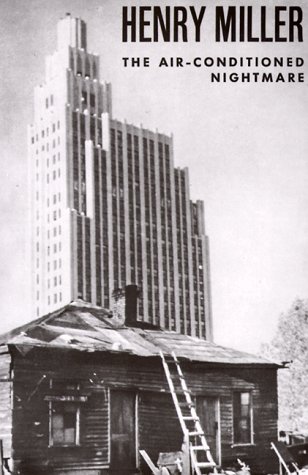Henry Miller
Review By Dan Geddes
See also review of Miller’s The Rosy Crucifixion
Henry Miller is famous for leaving New York for Paris in 1930, and writing sexually-explicitly literary novels that were banned in the United States for over thirty years. His notoriety spread, however, when American servicemen discovered Miller’s novels during the liberation of Europe in 1944-45, and smuggled copies entered the U.S.
Miller lived abroad for ten years, leaving France only three months before the outbreak of the Second World War. After a brief time in Greece (which produced his classic travelogue The Colossus of Marousi), Miller returned to America, and set out on a cross-country journey to re-discover his homeland. The result was The Air-Conditioned Nightmare (1945).
After an introduction about Miller’s ex-patriate status at the time of his cross-country trip, each chapter addresses a particular American locale, and an emblematic person from each stop on his journey.
Miller’s usual remarks about non-artistic people or places as dead is manifested throughout the book. While Miller’s prose vibrates with colorful insights and unusual words, he also issues summary judgments constantly. In that way, Miller is something of a moralist, a moralist in favor of the artistic-hedonistic lifestyle. Miller is a great champion for the bohemian life in both his life and work, but he often betrays his impatience with the lives of simpler folk. True, in the course of issuing so many judgments, he will arbitrarily single out certain simple folk for praise, but Miller’s work is so full of judgment, even as he protests, mock-modestly, about how little he knows.
So The Air-Conditioned Nightmare is a collection of sketches, all infused by Miller’s endless judgments and generalizations, variously insightful, humorous, poetic, elitist. Consider:
- “Walt Disney…is the master of the nightmare…Disney works fast—like greased lightning. That’s how we’ll all operate soon. What we dream we become. We’ll get the knack of it soon. We’ll learn how to annihilate the whole planet in the wink of an eye—just wait and see” (40-41).
- “The most difficult adjustment an expatriate has to make, on returning to his native land, is in this realm of conversation. The impression one has, at first, is that there is no conversation. We do not talk—we bludgeon one another with facts and theories gleaned from cursory readings of newspapers, magazines, and digests.” (109).
Since he eschews any importance at all to political movements, Miller feels free to say nearly anything in the way of criticizing the system. Many of his comments appear irresponsible. When he meets an ex-con on a train, Miller and his traveling companion later track him down to see if they can be of help to him. Miller fulminates that we are all as guilty as the ex-con, who has a heart after all, and that prisons only develop the criminal skills of his inhabitants. This is typical Miller: he does point out some of the worst aspects of the criminal justice system (as he does in other books), but of course cannot offer any practical alternative. He has only the idealists’ wish that war and crime would go away, and he apportions blame to society for causing these evils, and using naked force to maintain a corrupt society.
Miller does his job as a travel writer, providing the local color, the sights and the sounds and the personalities of each place. Miller’s main charm is his enthusiasm. Even while denouncing American cities as godforsaken holes, Miller prides himself on being able to find the good in it, the few eccentric characters that perhaps justify a place’s existence.
Much of Miller’s fulminating against the soullessness of America will be familiar to readers of other Miller books, such as Tropic of Capricorn. Americans are awash in consumer commodities, which they mistake for tokens of happiness. Miller’s critique of the American system is far from a Marxist one, though it may appear that way to some readers. Miller repeatedly avows that he is uninterested in political reform, and we don’t hear him calling for unionization of the workers. Miller’s critiques from the artist’s perspective, especially a supposedly spiritually motivated writer’s perspective. People must free themselves from their own slavery.
Miller repeatedly invokes the character of the 19th century Indian mystic Vivekananda as the greatest sage of our age. Vivekananda visited America, and attempted to spread his message; Miller tells us that one evening Vivekananda looked at the faces in the audience and found them so utilitarian minded that he was filled with despair, and refused to give his speech. Miller also enjoys European or Eastern sages to critique America’s spiritual bankruptcy.
Miller’s critiques appear all the more prescient, considering he was writing The Air-Conditioned Nightmare in 1940-1. He sees the mass media as bankrupt, and singles out newspapers, movies, radio and Disney for particular contempt. He doubts that radio’s world-wide reach will do anything to make humanity—especially Americans—feel more connected. “We get about as much information about the other peoples of this globe, through the movies and the radio, as the Martians get about us.” (44).
The Air-Conditioned Nightmare is an especially important Miller work, as it was not banned in the U.S., as were Tropic of Cancer and Tropic of Capricorn. Miller’s influence on the Beats is obvious. The Air-Conditioned Nightmare reads like the Ur-text for Kerouac’s On the Road. Miller’s songs of praise for sex, art, food, freedom from normal bourgeois life are all repeated by the Beat writers.
Dan Geddes
July 2002

